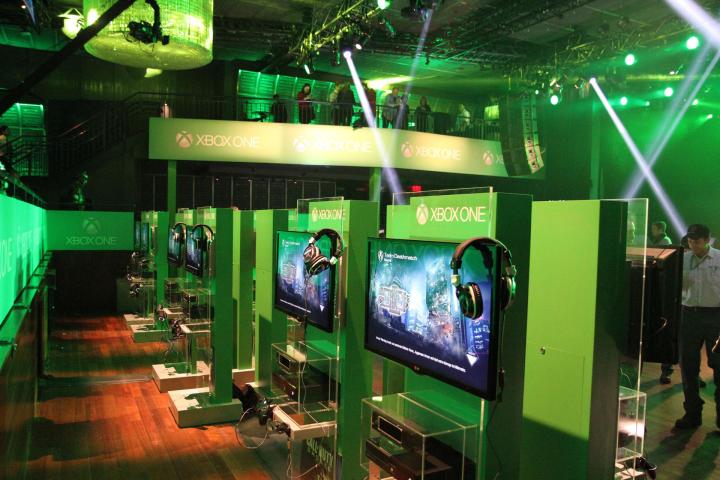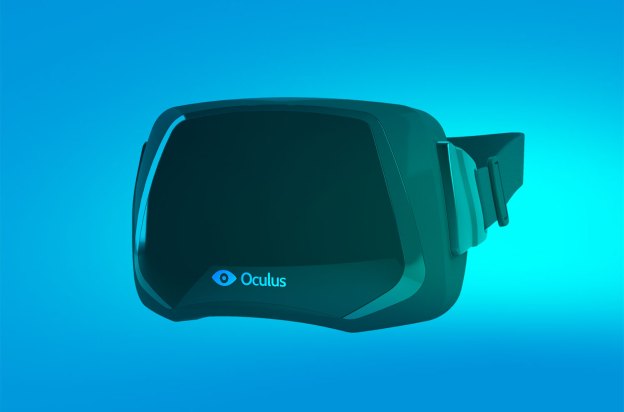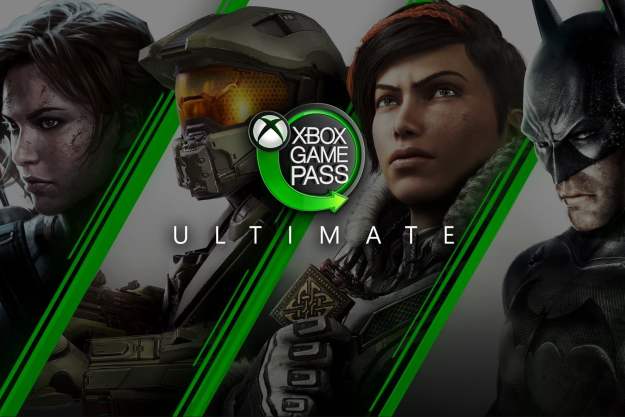
Thanksgiving in the 21st century is mostly about two things: gorging yourself on inhuman quantities of food, and watching a whole lot of football. Turkeys fear it, 9-to-5-ers love it, retailers steel their nerves. After all, it’s a last desperate gasp of relaxation before Black Friday descends, signaling the official start of the Holiday Shopping Season. Many of us use the day to look back and reflect on the year, giving thanks for all of the bright spots and high points.
Gamers have a lot to be thankful for in 2013. There’s been new hardware of all shapes and sizes, huge strides made in the realm of interactive storytelling, and individual works that speak to a bright future for this still-young entertainment form. We’ve had a lot of fun for sure, but we also at last have a sense of where things are moving next. So as you sit down to shove unhealthy amounts of turkey, stuffing, and mashed potatoes into your face, be sure to spare some thought for the delightful times we’ve had and those that are still to come once we close the book on this, the Year of Luigi (and a whole crapload of other stuff).
Make love, not (console) war
There’s a tendency to characterize the sales showdown between new hardware offerings from Microsoft and Sony as a “console war.” That’s accurate, but only to an extent. The two companies are indeed trying to outsell one another as they compete for your eyeballs and dollars. Let’s Real Talk here for a minute though: when two monolithic companies throw hundreds of millions of dollars into research, development, and manufacturing, the biggest winner of all is the end-user: You, the gamer. You stand to benefit the most from the retail tussle. The more these companies compete, the more innovation we tend to see on our TV screens.
There’s no shortage of new ideas encapsulated in both console offerings. Let’s look at Microsoft first. Its new Xbox One beat Apple to in the race to deliver voice-commanded TV viewing to your living room. The technology might not be 100-percent reliable just yet, but the basic act of saying “Xbox, watch ESPN” to flip channels without ever touching a remote control works, and it’s only going to improve with updates. The PlayStation 4 takes less of an all-in-one approach, but Sony’s redesigned operating system and newly integrated social media hookups establish the new hardware as a community-driven device that immediately appeals to community-focused gamers. Both systems bring along necessarily souped up horsepower as well, and gamers in turn are blessed with some of the prettiest launch titles the industry’s ever seen.

It goes deeper though. Each company’s core philosophy with the new consoles is built on the idea of disrupting norms. It’s something of a crossroads, a fork in the road that leads any discussion of console potential in different directions. For Microsoft, there’s a strong emphasis on turning the Xbox One into the central machine for your living room. Even if you’ve cut the cord and giving up cable TV like so many others, there’s the as-yet-unrealized potential of Microsoft’s original content plans. The Steven Spielberg-produced Halo series. The rumored street soccer deep-dive. Who knows what else? Cable companies like Comcast and Time Warner are already allowing subscribers to pay extra for HBO Go even if they don’t have cable TV. The tide is turning to give those with severed cords a way to consume content on their time without relying on piracy. That’s something everyone can be grateful for.
For Sony, there’s evidence of an unrivaled investment in supporting every corner of the game development community, from continuing partnerships with AAA studios to the new indie-friendly Pub Fund. The decision-makers at the company seem to recognize that Journey may not be Call of Duty, but both are nonetheless vital to the growth and evolution of the medium. Sony’s ongoing support for the PlayStation Vita also speaks to the company’s gamers-first focus. The immediately impressive execution of Remote Play in connection with the PS4 demonstrates tremendous promise, and the Vita’s own growing library of games – many of which come from the aforementioned indie commitment – continue to establish the little handheld as a potent competitor in its own right.
We don’t know what’s to come, but it’s an exciting time to be a gamer. We literally do not know what this hardware will look like in two years, and there is much promise in that mystery. So give thanks for these two new consoles, and the creativity the competition between them is sure to spur.
A future shaped by Lawnmower Man and other oddities
The two console titans make the most noise, but the upstarts arrayed around them are increasing in volume. The Oculus Rift virtual reality headset may not be ready for consumers just yet, but the wildly successful Kickstarter started shipping to backers early in the year. We’ve seen huge growth in recent months with regards to development for the platform. From CCP Games’ high-profile plans for the space dogfighting shooter EVE: Valkyrie to lesser-known but equally attention-worthy titles like Montague’s Mount – not to mention the ongoing efforts of many to patch support for the headset into older games – Oculus is a forward step. An early taste of a direction gaming is likely to head in over the next bunch of years. It’s poised to make a huge splash in 2014 when the long-anticipated consumer model finally arrives.

Then there’s the new iPad Mini, a revelatory piece of hardware for Apple that finally distills the potential of the iPhone and the iPad down into a perfectly sized form factor for gaming. The company has long resisted any suggestion that its products compete in the gaming arena, even as sales numbers in the App Store tell a very different story. The A7-equipped Retina Display Mini is Apple’s gaming handheld, whether or not the company frames it as such. Developers are genuinely excited to work with it, the major iOS 7 update brings in external controller support, and the mini-tablet is considerably more portable than the full-sized iPad. It’s already a workhorse with legacy games, and we’ve yet to even really get a taste of what’s possible with the 64-bit A7 processor.
Look at it like this: Star Wars: Knights of the Old Republic, a first-gen Xbox game, runs like a dream on the iPad Mini, better than it ever has before. In just a few short years since the iPhone was first introduced, we’ve gone from a simplified version of Super Monkey Ball to a port of an award-winning RPG that easily performs better than any of its predecessors. What else can this little tablet do?
Of course, we’d be remiss to not mention the real upstart of the bunch: Steam Machines. Valve isn’t happy with the Windows environment anymore, so it’s now moving to stake a claim on your living room with a plan for manufacturers to release console-sized PCs that run on a specifically tailored, open-source Linux-based operating system, SteamOS. It’s a total wildcard at this point, an unknown quantity that won’t step into the retail arena until sometime in 2014. But the promise of a third multimedia box for your living room to compete with the other two cannot be ignored.
For all that we’ve seen and all that is still to come from these boat-rockers, we give thanks.
The Year of Luigi

Nintendo is an easy target right now. The Wii U’s short-lived reign as the most powerful gaming console on the market officially ended with the launch of Microsoft and Sony’s hardware. Common sense suggests that the Wii successor’s prospects have officially dried up. After all, Nintendo’s hardware is underpowered, extremely limited from the perspective of online play, and saddled with a decentralized account system that makes investing in the company’s online infrastructure with eShop purchases a very scary proposition. Let’s not forget though: this is Nintendo we’re talking about.
Nintendo is a company that regularly defies the odds with monumental leaps of innovation. The Wii dominated the early days of the previous console generation with its mass audience-friendly approach. Who needs Call of Duty when you can play virtual tennis with dad and grandma in the living room? The Wii U doesn’t carry the same mass appeal as the Wii, but Nintendo’s first-party efforts – including the just-released Super Mario 3D World – prove that the company’s creative-types aren’t out of fresh ideas yet.
The 3DS is even more of a worthy contender as the underpowered juggernaut of the handheld gaming space. Yes, Sony’s Vita is a growing commodity, and there is absolutely an audience for the types of gaming experiences it offers. The 3DS is more universal though. It’s cheaper, it’s got a wider variety of games, and it benefits from the same creative exclusivity that keeps the Wii U competitive. There’s nowhere else you can play a Zelda game, nowhere else to spend time with Mario and Luigi. Also, Pokemon. Again and again, Pokemon. It’s easy to look at the most popular titles on Nintendo platforms and see the continual milking of franchises as a bad thing. The sales keep coming though, because Nintendo is, as ever, the video game company that could.

Now, with its back to the wall and more stiff competition than it has ever known, Nintendo is cornered. There’s a tremendous challenge here, but also a tremendous opportunity. We’ve seen signs of life from the Wii U in the back half of 2013, with Mario, with Pikmin 3, with the improbably excellent HD port of The Legend of Zelda: Majora’s Mask. We’ve seen continued growth for the 3DS as well, both with games and with the more kid-friendly 2DS. The gears are spinning. The time is ripe for a creative revolution. We may not recognize Nintendo in five years from now, but we know it’ll still be here.
So in this, the most glorious year of Luigi, we give thanks for Nintendo’s continued efforts to spread joy in its own, unique way.
All dem games
We’d be remiss not to mention what a stellar year of growth its been for the games themselves. In 2013, we’ve seen some truly impressive forward strides taken in the realm of interactive storytelling. From high-profile examples like Grand Theft Auto V‘s exceptionally involving three-pronged narrative, to underdog sensations like The Fullbright Company’s mind-blowingly excellent Gone Home, we’ve seen video game stories tread in genuinely fresh directions throughout 2013.

If you’re at all interested in how the medium of interactive entertainment continues to evolve, it behooves you to dig deep for the year’s shiniest gems. Here’s a short list to get you started: Gone Home, The Stanley Parable, Rogue Legacy, Papers Please, Device 6, Year Walk, The Nightjar, The Wolf Among Us, Brothers: A Tale of Two Sons. Sample these. Find others. Immerse yourself in the stories they’re telling. It’s breathtaking. We’ve come a very, very long way from the days of your princess being in another castle.
There are so very many games to fall in love with in 2013, and for that we are endlessly thankful.
Sleep.
The consoles are out, the blockbusters are launched, and the holiday season is nigh. For the games writers of the world, that means one thing: sleep. So much sleep. All the sleep you can imagine, and more. Good night, readers, and happy gorging. May your Thanksgiving celebration be filled with turkey and football and genuine thanks for the wonders this year has wrought.
Editors' Recommendations
- The biggest gaming news of 2023: Insomniac leak, GTA 6 reveal, and more
- We ranked all the best (and worst) video game system startup sounds
- Target Gaming Sale: Cheap games for Nintendo Switch, PS4, and Xbox One


